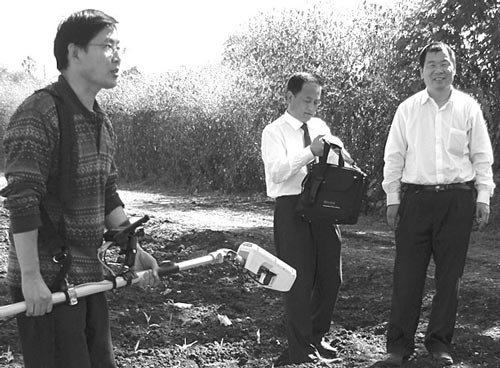Parliamentarians from World Bank member countries spent the first two of a four-day mission to Kenya visiting and interacting with CGIAR scientists, partners, and stakeholders. The dozen members of the Parliamentary Network of the World Bank (PNoWB) joined Senior CGIAR scientists on 11 and 12 September to debate three issues of major global concern: sustainable agricultural development in sub- Saharan Africa, avian influenza (bird flu), and climate change.
Marianne Bänziger, Wilfred Mwangi and Stephen Mugo participated in the panel discussion of September 11, led by Director of the Kenya Agricultural Research Institute (KARI) Ephraim Mukisira, John Lynam of the Kilimo Trust, and three other scientists. The debate covered an array of issues, including fertilizer prices, water use efficiency in agriculture, HIVAids, regional trade within the COMESA and East African Community blocs, national and regional rail and road infrastructure, land holding sizes, producer organizations, biotechnology, and African-womanfriendly farming implements, and explored the complex interrelations among these factors, as well as their impacts on agricultural development and poverty reduction. Kenyan MPs were well represented, contributing vigorously to the plenary discussions, at which several Kenya-based UN and NGO staff also participated.
The PNoWB members asked the CGIAR centers and national agricultural institutions to provide them with clear messages they could use in making policy decisions, and also to spell out the long-term impacts of the requested investments. Lynam put it to the meeting that given the 70% agrarian population in sub-Saharan African countries, “in order to get these economies going, you’ve got to get agriculture going.”
CIMMYT and the other CGIAR centers each mounted individual poster exhibitions on Day one. The CIMMYT stand featured several activities, including the Global Rust Initiative, our work on Conservation Agriculture, the Africa Maize Stress Project, IRMA, QPM and Striga research. We received a good level of traffic and interest, in particular from the Kenyan MPs who browsed the CIMMYT flyers displayed and took away copies. The parliamentarians visited a mixed smallholder farm in Thika, a small agro-industrial settlement about 80 km northeast of Nairobi that afternoon.
Day two (September 12) was devoted to bird flu and climate change discussions, held at ILRI (International Livestock Research Institute) headquarters, and led by Director Carlos Serè and ICRAF Deputy Director Jan Laarman. A field visit to pastoralist communities in the outskirts of Nairobi wrapped up the 2-day interaction with the CGIAR.
 Chinese journalists Fan Jian (center) of the Science and Technology Daily and Jianke Jiang (right) of the People’s Daily, accompany Xiaofeng Dai, Deputy Director General, Chinese Academy of Agricultural Sciences, as he handles an infrared sensor at the Tlaltizapán experiment station, as part of their visit to CIMMYT during November 28-December 2, 2006.
Chinese journalists Fan Jian (center) of the Science and Technology Daily and Jianke Jiang (right) of the People’s Daily, accompany Xiaofeng Dai, Deputy Director General, Chinese Academy of Agricultural Sciences, as he handles an infrared sensor at the Tlaltizapán experiment station, as part of their visit to CIMMYT during November 28-December 2, 2006.